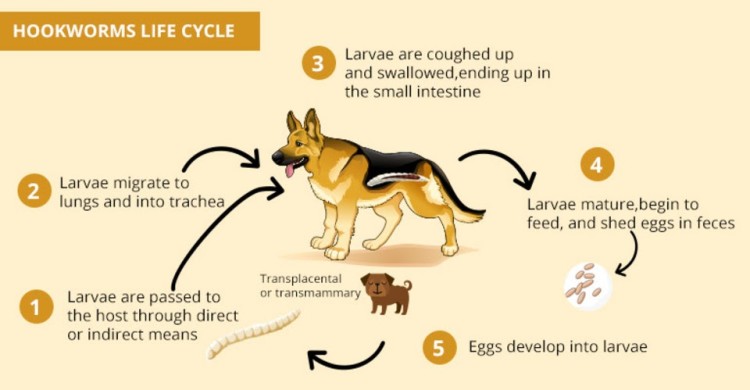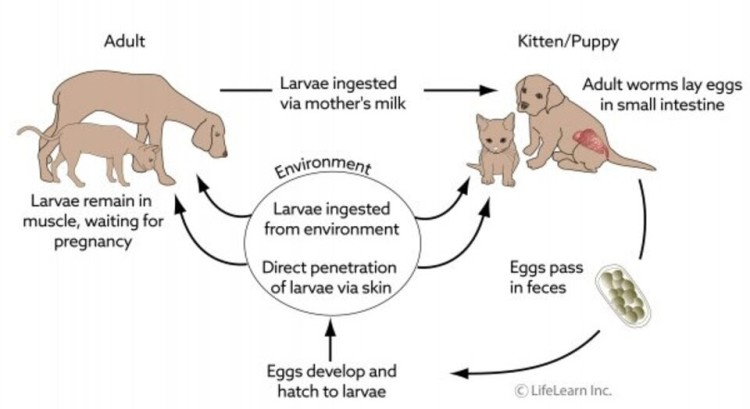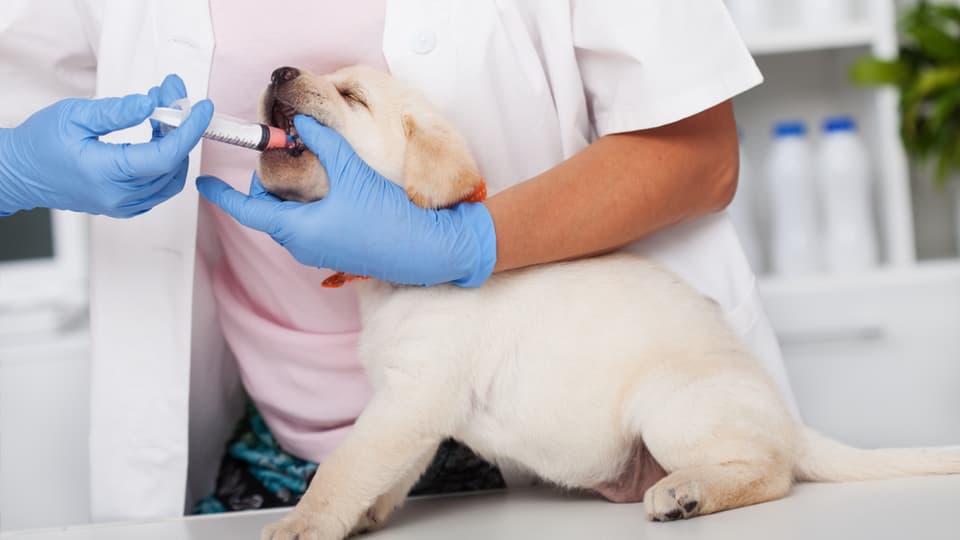Hookworms are one of the most common types of worms in dogs that can do some serious damage. What symptoms should you look out for? How do you treat hookworms in dogs? And is there anything you can do to prevent your beloved pet from getting these nasty parasites? This post answers all these questions and more.
Pro tip: By enrolling your pet early, treatments for illnesses like parasite infection can be covered up to 90% by your pet insurance.
Table of Contents:
- What are hookworms?
- How do dogs get hookworms?
- Can humans become infected with hookworms?
- What are the symptoms of hookworms in dogs?
- How do you diagnose a dog with hookworms?
- How do you treat hookworms in dogs?
- Can you prevent dogs from getting hookworms?
- Key Takeaways
What are hookworms?
Hookworms are hook-like parasites that attach themselves to a dog’s intestines. Despite only being 3mm long, these parasites can cause severe anemia (a decrease in your pet’s red blood cells).
There are several different kinds of hookworms that affect dogs. The most common one is Ancylostoma caninum which flourishes in warm and moist climates along with Ancylostoma braziliense. Uncinaria stenocephala, on the other hand, is present in cooler climates and affects dogs occasionally.
The life cycle of the hookworm has three stages: eggs, larvae, and adults. The adult hookworms reside and mate inside the small intestine of their hosts, and then females lay microscopic eggs that are passed in the poop. In about one week, the eggs hatch into larvae which infect the environment. These larvae may survive for two months in warm and moist conditions.
How do dogs get hookworms?
Canines can get infected with hookworms in several different ways. They can ingest larvae by eating or sniffing poop or soil, or by eating an infected cockroach or mouse. Hookworm larvae can also penetrate the skin, usually through the pup's paws.
After penetrating the skin or being swallowed, it takes about two weeks for the larvae to enter the bloodstream, reach the lungs, and settle in the small intestine where they mature. In adult dogs who have become immune to the parasite, the immature worms might enter a period of arrested development (hypobiosis) in the body. Months or even years later, the parasites can become reactivated, leading to an active infection. However, even if the animal has become immune and doesn’t show any abnormal signs, they can still contaminate the environment by shedding eggs in their feces.
When a female dog becomes pregnant, the larvae enter the mammary glands and infect the puppies when they nurse. For that reason, female dogs that are to be bred should get worm medication before giving birth in order to kill the larvae that might infect the puppies.
 (Image source: Budget Vet Care)
(Image source: Budget Vet Care)
Can humans become infected with hookworms?
Hookworm larvae are also capable of penetrating human skin, causing a skin infection called cutaneous larva migrans (CLM) which manifests in the form of small, red, itchy trails. Humans can be infected by walking barefoot on sandy beaches or lying on moist soil that’s been contaminated with animal feces.
Hookworms in humans can be dangerous. The larvae can penetrate internal organs and eyes, causing serious damage, complications, and blindness. Fortunately, these conditions can be easily avoided by avoiding contact with moist, infected soil. Bathing and washing hands regularly can also help prevent hookworm infection.
What are the symptoms of hookworms in dogs?
There are a few symptoms of hookworms in canines that pet parents should be aware of in order to help catch the infection early.
Hookworms suck blood and cause internal blood loss, which leads to anemia. The symptoms of anemia include weakness, pale gums, weight loss, and poor growth.
Hookworms are especially dangerous for young puppies who have no natural defense and can quickly develop a severe infection. Besides severe anemia, puppies might also have bloody to tarry diarrhea. Other symptoms of hookworms in puppies include:
- Weakness
- Unhealthy appearance
- Inability to gain weight
- Pale mucus membranes
- Poor haircoat
- Coughing
Some larvae can migrate to the lungs in both puppies and adult canines, which can result in respiratory disease and pneumonia. Massive hookworm infestation can lead to collapse and even death.
Adult canines usually develop chronic infection. Malnourished or stressed pups, as well as those living in regions where hookworms are common, are at a higher risk. Chronic disease is typically characterized by vomiting and mild diarrhea. Some dogs can also experience loss of appetite, weakness, and blood in the stool. The infection can be deadly even in adult animals if their immune system weakens.
Older dogs with ongoing exposure to the parasite may develop hookworm dermatitis. This most commonly affects the footpads and is called pododermatitis. Dogs with pododermatitis suffer from swollen and painful feet that become soft, spongy and feel hot. If left untreated, the footpads might separate, the pads turn cracked and dry and the nails become deformed.
How do you diagnose a dog with hookworms?
If your veterinarian suspects that your pet has picked up hookworm, they will perform a test called fecal float. Fecal float is an examination of a stool sample, where the stool material is mixed with a special liquid that causes the parasite eggs to float to the surface. The eggs are then collected using a glass slide which is examined under a microscope.
This diagnostic test is generally quite reliable as the parasite produces a big number of eggs on a regular basis. However, it may be less reliable in puppies, as it takes two to three weeks for the larvae to mature and start reproducing.
How do you treat hookworms in dogs?
If the presence of hookworms is confirmed, your vet will likely prescribe an anthelmintic or dewormer. These medications are usually taken orally and don’t cause any significant adverse effects, but they only kill adult hookworms and maturing larvae. This means that they might not manage to kill larvae in arrested development and, for that reason, the veterinarian will probably recommend treating your furry friend again in two to four weeks in order to get rid of any new adult worms formed from the surviving larvae.
In cases of severe hookworm infection, deworming treatment can be combined with supportive therapy, which can include a high-protein diet, fluid therapy, and iron supplementation. Make sure to follow your vet’s instructions in order to ensure that all the hookworms are eliminated.
If your dog’s immune system breaks down and you start noticing symptoms similar to the acute infection, be sure to contact your vet right away. This is an emergency situation that might require hospitalization, supportive care, and blood transfusion.
In the case of pododermatitis, medicated paste will also be applied to the affected area.
Pro tip: With regular worm and flea treatment, your dog will be healthier and happier. This will also help keep the cost of your pet insurance premiums down. If you do find your canine companion needs treatment, pet insurance can help limit the amount you have to pay at the vet’s office.
 (Image source: VCA Animal Hospital)
(Image source: VCA Animal Hospital)
Can you prevent dogs from getting hookworms?
When it comes to hookworm infection, good hygiene is the best prevention. Be sure to pick up dog feces as soon as possible, because it takes six days for the hookworm larvae to leave the poop. If hookworm eggs are not in the environment, other animals can’t get infected.
The risk of infection is highest in shaded and damp areas, so kennel areas should be kept clean and dry. In addition, make sure to cover sandboxes so that they won’t become contaminated by animals randomly passing by.
Disinfection is also very important. Concrete runs can be cleaned with a 1% bleach solution. Applying borax or rock salt to sandy or gravel runs will kill the worms (it should be noted though that these two substances will also kill the grass).
Avoid areas where there are large amounts of feces (like dog parks) and avoid taking your pooch to facilities that don’t follow standard cleaning and disinfecting protocols.
Deworm dogs on a regular basis using an anthelmintic approved by your vet. Puppies should be dewormed at 2, 4, 6, 8, and 12 weeks of age and then every month. Nursing dogs should be dewormed at the same time their puppies are. In addition, prompt deworming should be given if the parasite is detected.
Speak to your vet about adding a heartworm preventative that protects against hookworms to your pet’s preventative care plan.
Key Takeaways
- Hookworms are common parasites in dogs that can also affect humans.
- Young puppies are at the highest risk for blood loss due to hookworms, which is why it’s very important to deworm on a regular basis.
- Knowing the symptoms and how to prevent your pet from getting infected will help keep them healthy and happy.
- If you have questions or concerns about hookworms, your vet is always the best source of information.
